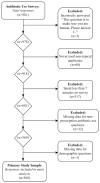Healthcare System Distrust and Non-Prescription Antibiotic Use: A Cross-Sectional Survey of Adult Antibiotic Users
- PMID: 36671280
- PMCID: PMC9854942
- DOI: 10.3390/antibiotics12010079
Healthcare System Distrust and Non-Prescription Antibiotic Use: A Cross-Sectional Survey of Adult Antibiotic Users
Abstract
Antibiotic resistance is a major public health concern driven by antibiotic overuse. Antibiotic stewardship programs are often limited to clinical settings and do little to address non-prescription antibiotic use in community settings. This study investigates the association between non-prescription antibiotic use and healthcare system distrust in the United States and Mexico. An online survey was deployed in the United States and Mexico with enhanced sampling through in-person recruiting in the border region. Non-prescription antibiotic use was defined as having bought or borrowed non-prescription oral or injectable antibiotics within the last 3 years. The survey included a previously validated 10-item scale to measure healthcare system distrust. Logistic regression was used to model the use of non-prescription antibiotics by the level of healthcare system distrust, adjusted for demographic characteristics and antibiotic knowledge. In total, 568 survey participants were included in the analysis, 48.6% of whom had used non-prescription oral or injectable antibiotics in the last 3 years. In the fully adjusted regression model, the odds of using non-prescription antibiotics were 3.2 (95% CI: 1.8, 6.1) times higher for those in the highest distrust quartile versus the lowest. These findings underscore the importance of community-based antibiotic stewardship and suggest that these programs are particularly critical for communities with high levels of healthcare system distrust.
Keywords: antimicrobial resistance; antimicrobial stewardship; non-prescription antibiotic use; trust in healthcare system.
Conflict of interest statement
The authors declare no conflict of interest.
Figures
References
LinkOut - more resources
Full Text Sources



